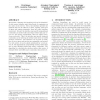Free Online Productivity Tools
i2Speak
i2Symbol
i2OCR
iTex2Img
iWeb2Print
iWeb2Shot
i2Type
iPdf2Split
iPdf2Merge
i2Bopomofo
i2Arabic
i2Style
i2Image
i2PDF
iLatex2Rtf
Sci2ools
105
Voted
WWW
2005
ACM
2005
ACM
Web service interfaces
We present a language for specifying web service interfaces. A web service interface puts three kinds of constraints on the users of the service. First, the interface specifies the methods that can be called by a client, together with types of input and output parameters; these are called signature constraints. Second, the interface may specify propositional constraints on method calls and output values that may occur in a web service conversation; these are called consistency constraints. Third, the interface may specify temporal constraints on the ordering of method calls; these are called protocol constraints. The interfaces can be used to check, first, if two or more web services are compatible, and second, if a web service A can be safely substituted for a web service B. The algorithm for compatibility checking verifies that two or more interfaces fulfill each others' constraints. The algorithm for substitutivity checking verifies that service A demands fewer and fulfills mo...
Internet Technology | Web Service B | Web Service Conversation | Web Service Interfaces | WWW 2005 |
Related Content
| Added | 22 Nov 2009 |
| Updated | 22 Nov 2009 |
| Type | Conference |
| Year | 2005 |
| Where | WWW |
| Authors | Dirk Beyer, Arindam Chakrabarti, Thomas A. Henzinger |
Comments (0)

